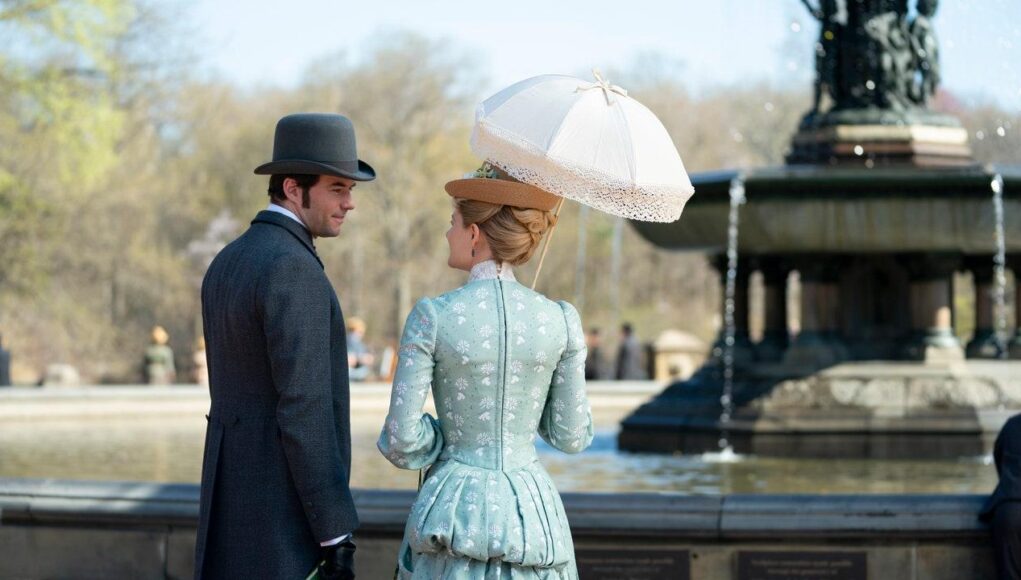As The Gilded Age opens, horse-drawn carriages transport European decorative treasures—furniture, tapestries, statuary—to the still-under-scaffolding white limestone mansion architect Stanford White has designed for ruthless railroad magnate George Russell (Morgan Spector), and his social-climbing wife Bertha (Carrie Coon) on Fifth Avenue. Their blue blood neighbors, Agnes van Rhijn (Christine Baranski) and her sister, Ada Brook (Cynthia Nixon), eye the goings-on from a drawing room window of their 1850 brownstone across East 61st Street.
It’s about a decade into the American Renaissance, a period of extraordinary growth and innovation from the 1870s to the 1920s, in which real-life industrialists like the Russells were building private homes, and along with patrons and politicians, commissioning clubs (The University Club), commercial (The Belvedere Hotel) and municipal (Minneapolis Institute of Art) buildings, public roadways (the Brooklyn Bridge), monuments (The Farragut Monument), and churches (Madison Square Presbyterian Church). Their architectural style—an American interpretation of Beaux-Arts classicism—came to define the era, gaining popularity after a showcase at the 1893 Chicago World’s Fair, according to architect Phillip James Dodd, author of An American Renaissance: Beaux-Arts Architecture in New York, a lavish new book with a forward by the HBO series’ creator Julian Fellowes.
Known for its grandeur and sculptural decoration, Beaux-Arts design as interpreted by the Gilded Age’s star architects—who like their clients strove to outdo each other—is an amalgamation of neoclassic styles, including Gothic Revival, French Baroque, Italian Renaissance, and Roman classical. The name comes from the training in Roman and Greek classicism that some of the men received at the École des Beaux-Arts. (Massachusetts Institute of Technology imported a French architect for an American program in 1893.) Richard Morris Hunt, the Parisian school’s first American graduate, was the era’s most sought-after architect. The Vanderbilt family’s go-to designer responsible for their Biltmore and Breakers estates, Hunt is also known for the majestic entrance to the Metropolitan Museum of Art, and the Statue of Liberty pedestal. Also in demand was Hunt’s protégé George Post, who had studied engineering, and designed the Williamsburgh Savings Bank, and The New York Stock Exchange.
Charles McKim, the senior partner at McKim, Mead & White—the country’s first modern architecture firm, and a training ground for many other influential architects—attended the École about a dozen years after Hunt. The Pierpont Morgan and Boston Public Libraries, and the Harvard Club are among his creations.
Influenced by European landmarks—“especially the Gothic architecture of England and France,” Dodd notes—the architects were aided by new steel-framing technology that allowed them to reject strict classical interpretations for more “eclectic” designs that although familiar, were distinctly American, says Dodd. So men like McKim, Mead & White alumni Cass Gilbert could “design both New York City’s neoclassic Alexander Hamilton U.S. Customs House, and a number of years later, the Gothic-inspired Woolworth Building,” the world’s tallest skyscraper from 1913 until 1930.
Though all of Hunt’s Manhattan houses were razed, the opulent Rhode Island residences he designed remain. Some of their interiors can be seen in The Gilded Age, production designer Bob Shaw tells AD. The music room at The Breakers, Cornelius Vanderbilt II’s Hunt-designed Italian Renaissance-style palazzo, became the Russell’s ballroom (which Bertha hopes to fill with socialites for daughter Gladys’ debutante ball), and the billiard room George’s smoking room. Shaw says the Renaissance-revival look of Consuelo Vanderbilt’s formal red wood-paneled bedroom in her parents William and Alva Vanderbilt’s Petit Trianon-inspired Marble House was well-suited to be the railroad tycoon’s. The Belcourt cottage doubled as Mrs. Astor’s estate.
Because Shaw had to sync soundstage interiors with real rooms, the Russell house’s architectural details aren’t “purely Stanford White”—ironic given that Bertha specifically choses the McKim, Mead & White partner, and designer of the original Pennsylvania Station (and George’s new station in the series), over Hunt. The Russell’s carriage entry was inspired by the drive at Andrew Carnegie’s 64-room Georgian mansion. (Designed in 1899 by the firm Babb, Cook & Willard, it’s now the Cooper Hewitt Museum.)
Bedrooms at Chateau-sur-Mer, which Hunt remodeled for Rhode Island senator George Peabody twice, stood in for the New York City bedrooms of Agnes van Rhijn, and socialite Anne Morris (Katie Finneran) and her Alderman husband (Michel Gill). The entrance hall and dining room became those of doyenne Mamie Fish (Ashlie Atkinson).
While some well-preserved 19th-century blocks in Troy, New York, stood in for the show’s Manhattan streets, many U.S. cities—including Baltimore, Chicago, Cleveland, Detroit, and Washington, D.C.— boast their own Beaux-Arts buildings. San Francisco’s City Hall, designed by architect Arthur Brown, Jr., has a dome 42 feet higher than the U.S. Capitol’s. The 1915 building replaced the original structure destroyed in the 1906 earthquake. Missouri’s Kansas City Union Station opened in 1914, closed in 1985, and after a comprehensive restoration in the 1990s, housed several museums by 1999. It reverted to a train station in 2002. Los Angeles’ Higgins Building was named for its owner, Thomas Higgins, who commissioned Albert C. Martin to create a concrete office building; it’s now condominiums. The Italian Renaissance-style Detroit Institute of Arts opened in 1927, and now has one of the country’s largest and most important art collections. Wisconsin’s 1915 neoclassical revival Ashland County Courthouse is on the National Register of Historic Places.
And if The Gilded Age returns to Pennsylvania—which the season finale indicates is a possibility—perhaps we’ll see Harrisburg’s 1906 Capitol building designed by Philadelphia architect Joseph Huston with a dome modeled on St. Peter’s Basilica in Rome.








